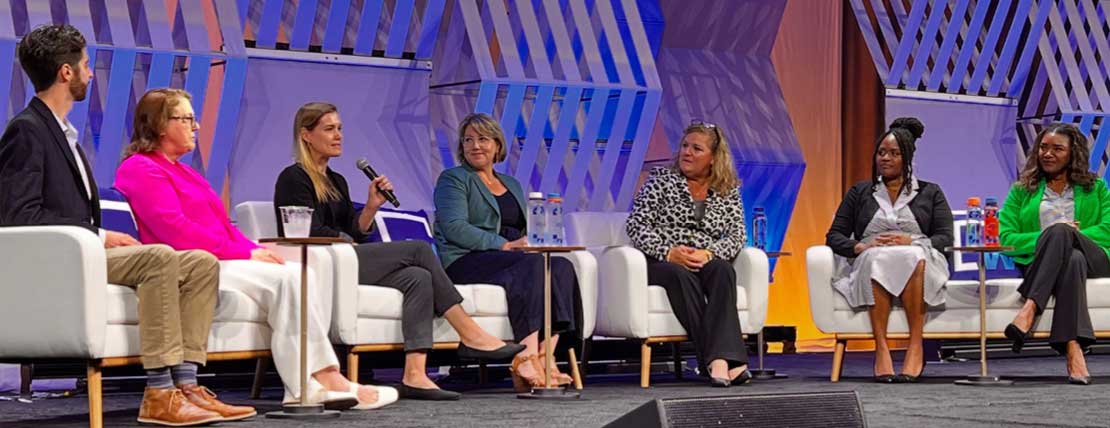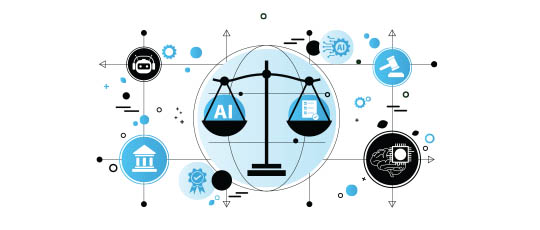For WorldatWork Members
- Measuring Up Mentorship Programs, Workspan Magazine article
- Skills-Based Mentoring: An Efficient Way to Build Skills, Workspan Daily Plus+ article
- High Potential: The Power of Job Rotation, Shadowing and Stretch Goals, Workspan Daily Plus+ article
For Everyone
- Mentoring and Reverse Mentoring: Two Sides of a Valuable Coin, Workspan Daily article
- Internal Investment: The Rewards of a Job Rotation Program, Workspan Daily article
- Invest in Career Development to Retain Young Talent, Workspan Daily article
What happens when rising talent meets the right guide at the right time? You get:
A) Growth
B) Breakthroughs
C) Lasting impact
D) All the above
Three corporate pairs of mentors and mentees shared their “all the above” experiences and outcomes during Tuesday morning’s main stage session at WorldatWork’s Total Rewards ’25 conference in Orlando, Fla.
The panel discussion, titled “Empowered Journeys: The Transformative Power of Mentorship,” included total rewards (TR) and human resources (HR) professionals from:
- Salsify: mentor Lisa Barry, vice president of total rewards and people operations, and mentee Daniel Reardon, senior manager of total rewards
- St. Charles Health System: mentor Hillary Forrest, senior director of human resources, and mentee Morgan Prin, compensation manager
- Corpay: mentor Mary McCorvey, chief people officer, and mentee Ilissa May, director of global compensation
Cathy Peffen, owner and principal of CMP Consulting, served as the session moderator.
(Pictured in above photo [left to right]: Reardon, Barry, Prin, Forrest, Peffen, May and McCorvey.)
These practitioners shared compelling stories of how they faced high-stakes moments and emerged stronger through collaboration, courage and support for one another. Each story showcased how an experienced leader formally or informally mentored a rising professional on their team through a complex challenge, revealing the human side of TR and the incredible potential that unfolds when experiences, wisdom and insights are shared. Leaders gave back to the HR/TR profession in such instances but received just as much in return.
Check out other Workspan Daily articles from Total Rewards ’25:
- Might a Sales Mindset Be Your Key to Total Rewards Success?
- The Keys to Creativity and Driving Innovative Total Rewards
- Proactive TR Pros See ‘Train’ of Change Coming, Take Steps to Act
- The Pros and Cons of Giving Managers Discretion on Merit Increases
- Using Analytics, Innovative Framework to Transform HR/Total Rewards
- How An Industry Leader Sees Technology Transforming Total Rewards
- Biopharma Compensation Leader Has Put AI Under the Microscope
- Boldyn Networks Offers a Bolder Approach to Employee Well-Being
Synergies at Salsify
Salsify is a 600-employee, Boston-based software company that helps businesses centralize and manage their digital product content to ensure a consistent, engaging, cross-channel consumer experience. Faced with budget constraints and rising costs, this team of mentor Barry and mentee Reardon learned how data storytelling, empathy and strategic thinking could move the business forward and unlock new leadership potential.
“Last year was a perfect storm for us [from a TR budget perspective] because we had the merit budget to work with, but we also had a significant U.S. medical increase. On top of that, we believed it was important to roll out a 401(k) match this year — something leadership had previously flagged as a priority for when we reached this stage of growth,” said Reardon. “We knew we needed to take a more holistic approach — really think not in terms of just compensation or just benefits but instead bring it all together and have an educated conversation with the executive team, weaving stories with that data so they could make the important decisions around those tradeoffs and what we wanted to fund and didn’t want to fund.”
VP Barry assisted Reardon through the process by instructing him how to best present data, consider what was important and top of mind with executives, and prepare for likely comments and questions.
“I would ask the questions, but I wasn’t the one providing the answers,” said Barry. “Dan was going to have to provide the answers to me. So, it was a balance of stepping back and letting Dan shine, but with my support and continuous feedback.”
The outcome was a win for the HR/TR team, the organization and employees.
“We rolled out our 401(k) match as of June 1,” Reardon said. “We do have a cap this year on it, so it was a compromise. We did make our benefits a bit more competitive. We did a market analysis and found that peers were charging employees more than we were for medical insurance. That insight helped us make adjustments to be more market-aligned on benefits costs while freeing up funds to support merit increases and the new 401(k) match. We stayed true to our comp philosophy and we kept the merit budget as we had recommended. So, we felt we had a really good outcome. We felt the executive team appreciated that we led with data, had a strategic conversation with them and weren’t just asking for money. I think it really helped build the brand of our HR team as well.”
Reardon said the best advice he has received from Barry is to “always be on the lookout for the ‘creative yes.’”
“We are often in a position where, by default, we are the ‘no’ police,” he said. “Someone in the business comes to us and says, ‘I want to do this.’ We know what they’re asking for, but it doesn’t fit within our policies or processes. However, instead of simply saying, ‘That’s not possible,’ we need to dig deeper and understand what is at the core of what they’re asking for. From there, perhaps we can come up with maybe a different solution, something creative that can work within our processes and can solve that leader or manager’s need.”
Sharing at St. Charles Health System
St. Charles Health System, Inc. is a four-hospital network and healthcare company in central Oregon with more than 3,000 employees. In the aftermath of the pandemic, mentor Forrest and mentee Prin reimagined TR to rebuild trust, engagement and stability — learning resilience, creativity and the power of partnership along the way.
“We were starting to roll out a new kind of total rewards framework, but then the pandemic hit and it was all-hands-on-deck for the next few years,” said Prin. “At the organization’s lowest point, we were at a 27% vacancy rate. Burnout in the workforce was high. There was a lot of union activity, too. So, we’ve had to implement a myriad of different TR solutions to try to attract and retain workers and really address the situation.”
Senior HR director Forrest mentored Prin by allowing the rising compensation manager to play to her strengths and then supplementing that with guidance in areas such as leadership and union negotiations.
“Morgan has really been our compensation expert,” said Forrest. “For me, it’s been just having that trust, and really being able to watch her fly free and gain her skills and develop and create compensation structures. I have helped in terms of the dynamics of building a team and managing those difficult conversations with other leaders and presenting data to the executive team in light of budget constraints and more.”
Support also comes in advising Prin before, during and after union contract discussions since, as Forrest stated, “That’s where I’ve spent much of time in my career.”
By learning from one another (Forrest said she has taken note of Prin’s ability to bring “the science to compensation”) and creatively addressing workforce challenges through TR, the organization was able to cut its vacancy rate to around 5%.
Said Forrest, “Some of the best advice I’ve gotten from my own mentors is to try not to let your fears or obstacles get in the way. I’ve shared that with Morgan, and I think we’ve learned and applied that together along the way.”
Collaboration at Corpay
Corpay, Inc. is an Atlanta-headquartered global business payments and spend management company, providing solutions that control expense-related purchasing and payment processes. Charged with building job architecture from scratch, the duo of mentor McCorvey and mentee May discovered how clarity, structure and confidence can elevate both a career path and a corporate culture.
“Coming out of the pandemic, I was getting more and more comp requests,” said compensation director May. “Employees were getting high external increase offers and managers were wondering, ‘What can we do to retain them?’ At the time, it was almost impossible for me to say how much you could give, and provide parameters to those requests, because we did not have solid salary structures — job structure, job architecture. We just didn’t really have any compensation foundation.”
May was able to create that structure through market data, framework design and job mapping. But when it came to communicating the outputs, she said “less than 5% of our people managers attended the information sessions.”
Enter chief people officer/mentor McCorvey. “I enlisted her help since Mary is all about people — she’s got people in her heart,” said May. “Working together, we talked to and trained our senior leaders first, so they were familiar with the concepts. We’re going after our middle managers next; those conversations are upcoming.”
Through McCorvey’s coaching and May communication, the new framework was incorporated into Corpay’s annual compensation review cycle.
“We’ve received good feedback, and our managers are understanding how they could assess pay equity, how they understand job leveling and all of those details that go with the job architecture,” said May.
McCorvey said this example calls out the power of mentoring programs.
“This is about being and staying curious,” she said. “Life is about learning from your experiences — whether you are sharing your journey or learning from someone else’s journey. The quality of giving back is part of your legacy.”
Editor’s Note: Additional Content
For more information and resources related to this article, see the pages below, which offer quick access to all WorldatWork content on these topics:







